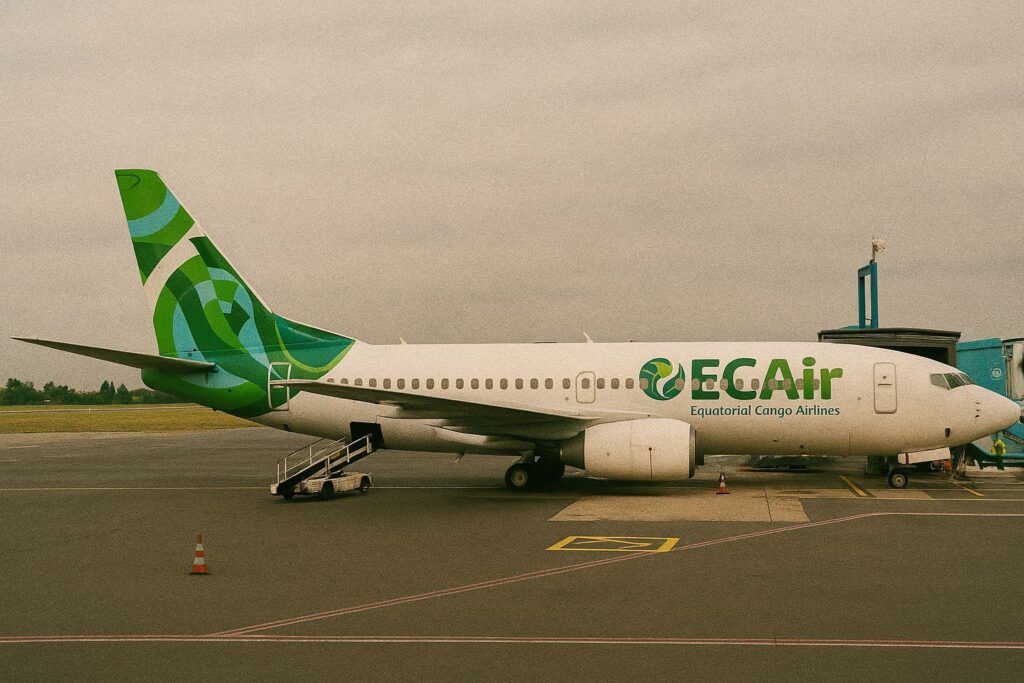A Symbolic Take-Off After Eight Years on the Ground
When flight LC701 pushed back from Brazzaville’s Maya-Maya tarmac at dawn on 1 July, observers noted more than the routine hum of CFM engines. It was the first regional sortie for Equatorial Congo Airlines since the carrier’s suspension in 2016, a hiatus brought on by adverse market conditions and a challenging balance sheet. In an era where many African flag carriers have faded permanently, ECAir’s re-emergence represents a noteworthy reversal, crafted through a gradual domestic redeployment that already counts 118 000 passengers since May 2024, according to internal traffic data corroborated by the African Airlines Association (AFRAA).
Strategic Return to Libreville, Douala and Yaoundé
The choice of Libreville, Douala and Yaoundé is neither accidental nor purely commercial. These three capitals form a dense triangle of trade flows and diplomatic exchange in the Gulf of Guinea corridor. Libreville hosts the CEMAC Commission, Douala remains Central Africa’s busiest maritime gateway, while Yaoundé functions as a key node for regional security consultations. ECAir’s thrice-weekly rotations, operated with Boeing 737-700 aircraft configured for 120 seats, promise a capacity of nearly 30 000 additional annual seats in a market where demand recovery has hovered around ninety per cent of pre-pandemic levels, according to IATA’s April 2024 Africa traffic bulletin.
State Backing and Regulatory Confidence
Congolese authorities have openly endorsed the relaunch. “Our aviation strategy is inseparable from our economic diplomacy,” Minister of Transport Jean-Marc Thystère-Tchicaya stated to the national press, emphasising President Denis Sassou Nguesso’s directive to restore the country’s aerial sovereignty. That political will is underpinned by tangible safeguards: maintenance contracts with Lufthansa Technik, crew training at the Ethiopian Aviation Academy and an enhanced IOSA audit scheduled for early 2025. The Civil Aviation Authority of Congo reports that international insurers have now reinstated hull and third-party liability coverage at pre-2016 premiums, signalling restored confidence in the airline’s operational discipline.
Regional Integration and CEMAC Ambitions
Beyond commercial metrics, the new frequencies carry diplomatic weight. The CEMAC agenda for free movement—ratified in 2021 but still unevenly applied—requires tangible connectivity. By offering same-day returns between the three capitals, ECAir addresses what the CEEAC Secretariat recently called the “missing physical layer” of integration. Analysts at the Central Africa Economic and Monetary Institute forecast that each percentage point improvement in intra-regional air capacity delivers a 0.3-point rise in cross-border trade volumes. For Brazzaville, championing that capacity burnishes its image as a facilitator of sub-regional cohesion.
Economic Multiplier for Tourism and Trade
The relaunch comes at a moment of cautiously rising commodity prices, with Congo’s non-oil sectors seeking diversification. Tour operators in Pointe-Noire report a 20 percent increase in Gabonese bookings since reservation systems opened in early June. Meanwhile, freight forwarders in Douala anticipate quicker consignments of Congolese timber and agri-produce. “Time-sensitive cargo such as fresh fruit gains at least 36 hours compared to the maritime option,” notes Prosper Ndinga, director of a Douala-based logistics firm. These micro-gains can translate into macro-benefits: the World Bank’s 2023 Logistics Performance Index shows that every day saved in transit in Central Africa decreases final consumer prices by 0.8 percent on average.
Fleet Expansion and West African Horizons
ECAir’s chairman, Fatima Beyina-Moussa, confirms negotiations for two Embraer E190-E2 jets and one additional 737-800, aircraft types well-suited to thinner routes. Targeted destinations include Abidjan, Lagos and Cotonou in 2025. Such ambitions align with the Single African Air Transport Market (SAATM) initiative, which Congo ratified in 2022. Industry observers believe ECAir’s measured growth—avoiding the rapid overreach that hampered earlier efforts—could serve as a case study for sustainable flag-carrier revival on the continent.
Navigating the Post-Pandemic Aviation Landscape
Central African skies remain crowded with uncertainty. Jet-fuel costs linger above 115 USD per barrel equivalent, and skilled aviation personnel are in global shortage. Yet, the region also boasts one of the world’s highest projected passenger growth rates at 5.7 percent annually, according to Airbus’s Global Market Forecast. In that delicate balance of risk and reward, ECAir’s disciplined comeback carries strategic significance. Congo-Brazzaville positions itself not merely as a point on the map but as an orchestrator of mobility in a corridor critical for the African Continental Free Trade Area. For now, each successful take-off tallies evidence that a state-backed but commercially minded flag carrier can, with prudence, reclaim altitude in the competitive African sky.

